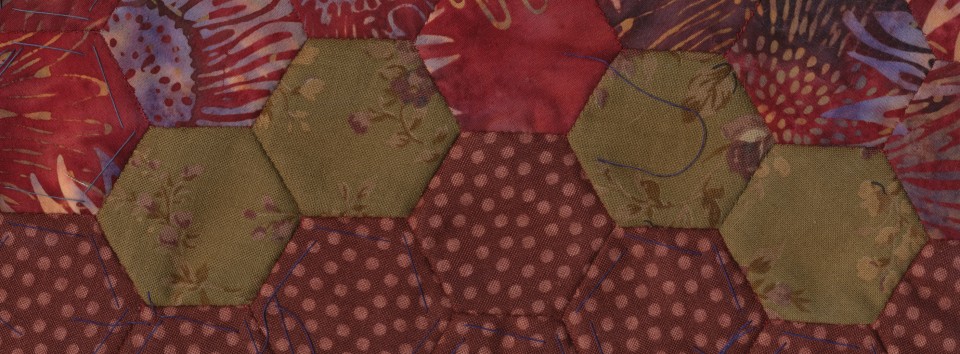When I first started to quilt with hexagons I decided to time how long it takes for me to baste a hexagon. I baste a lot of hexagons to have on hand, and I sometimes don’t have a project in mind for them when I do the basting. I discovered that it took me 1 minute and 20 seconds to baste a hexagon. That included cutting papers, cutting fabric squares, basting the fabric to the paper squares and trimming away excess fabric to leave behind a quarter inch seam. I came up with this figure by timing some batches of each of these processes and adding together the average figures. I decided that I would round the time up to a minute and a half for purposes of estimation assuming that I was probably working a bit quicker than I might ordinarily do because I was timing myself.
Recently I decided to time my sewing of the one inch seams on the sides of the hexagons as I piece them together. I had estimated that these seams would take me a minute and a half each. I based this estimate on some small units I had completed and timed earlier. I hoped I might have gotten faster in the interim.
I used the timer on my iPhone to time the sewing of the hunter green hexagons around my large diamonds for my Diamond Quilt that is currently in process.
I started and stopped working at least ten times along the way over the course of two days to finish the border.
I was quite surprised to see that it took me a tiny bit over six hours to piece that border. There are 56 hexagons in the border. It takes a total of 160 seams to attach the 56 hexagons in the border. That comes to a disappointing 2 minute and 15 seconds per seam. I was quite surprised that I was as slow as that. The seams themselves don’t appear to take that long, and they actually don’t. What adds to the time estimate per seam is the time spent threading the needle at the start of a new thread, rethreading the needle when a thread manages to slip out of one’s hand or when the thread breaks from too much tension. In addition to that time is spent reinforcing the points and running the thread up the side when adding a new hexagon to the border. The unnecessary time wasters are when one must untangle a knot in a thread, or when a thread breaks from too much tension resulting in too little thread to finish off a seam. In that event, it is necessary to pull out an already sewn seam one stitch at a time until the thread is long enough to finish off properly. Problems can be minimized by working with shorter threads and finishing them off when there is at least eight inches left. It is false economy of time to try to work with too long a thread, or to try to use every inch of thread.
Having found that my seams take 2.25 minutes to sew and that my hexagons take 1.5 minutes to baste I was able to estimate that each hexagon represents a surprising 15 minutes of effort. Therefore, every four hexagons represents an hour of labor.
I will admit to being surprised by all of this. I know piecing hexagons is slow work, but I had no idea just how slow. I always felt as if I were moving along at a nice clip when I was sitting on the couch sewing. Perhaps that is because it is so enjoyable an activity. The news that I am spending my life this way is not going to dissuade me from hand sewing. It certainly does, however, give me a good idea of the value of my work in terms of the time invested. If I ever give away a hand pieced quilt I will be able to say how long it took me to make.
Just for kicks I decided to time the removal of basting threads and papers from one of the largest green patterned borders on my large diamonds. There are 48 hexagons in the patterned green border, and it took me 8 minutes and 44 seconds to remove the basting threads and papers from the border.
That comes to 11 seconds per hexagon to remove papers. Considering that I had rounded up the basting of each hexagon by 10 seconds, this amount of time spent removing threads and papers makes up neatly for that rounding.




Pingback: Diamond Quilt Progress: Post Five | Hexy Lady
I should do something similar. I have so much time into mine, enjoyable time, but still a lot of it.
I do think it is worth knowing where the time is going. Give it a try.